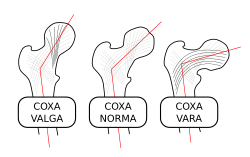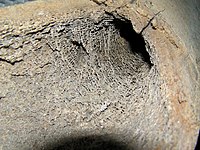| Trabecula | |
|---|---|
 Alternation of trabecular pattern in the thigh bone reflects mechanical stress | |
| Details | |
| Part of | Bone |
| Identifiers | |
| FMA | 85273 |
| Anatomical terminology | |
This article needs additional citations for verification. (May 2017) |


A trabecula (pl.: trabeculae, from Latin for 'small beam') is a small, often microscopic, tissue element in the form of a small beam, strut or rod that supports or anchors a framework of parts within a body or organ.[1][2] A trabecula generally has a mechanical function, and is usually composed of dense collagenous tissue (such as the trabecula of the spleen). It can be composed of other material such as muscle and bone. In the heart, muscles form trabeculae carneae and septomarginal trabeculae,[3] and the left atrial appendage has a tubular trabeculated structure.[4]
Cancellous bone is formed from groupings of trabeculated bone tissue. In cross section, trabeculae of a cancellous bone can look like septa, but in three dimensions they are topologically distinct, with trabeculae being roughly rod or pillar-shaped and septa being sheet-like.
When crossing fluid-filled spaces, trabeculae may offer the function of resisting tension (as in the penis, see for example trabeculae of corpora cavernosa and trabeculae of corpus spongiosum) or providing a cell filter (as in the trabecular meshwork of the eye).
- ^ "Definition of TRABECULA". www.merriam-webster.com. Retrieved 2017-09-24.
- ^ "trabecula". The Free Dictionary.
- ^ Goo, Soyeon; Joshi, Purva; Sands, Greg; Gerneke, Dane; Taberner, Andrew; Dollie, Qaasim; LeGrice, Ian; Loiselle, Denis (October 2009). "Trabeculae carneae as models of the ventricular walls: implications for the delivery of oxygen" (PDF). The Journal of General Physiology. 134 (4): 339–350. doi:10.1085/jgp.200910276. ISSN 0022-1295. PMC 2757768. PMID 19752188.
- ^ Srivastava MC, See VY, Price MJ (2015). "A review of the LARIAT device: insights from the cumulative clinical experience". Springerplus. 4: 522. doi:10.1186/s40064-015-1289-8. PMC 4574041. PMID 26405642.